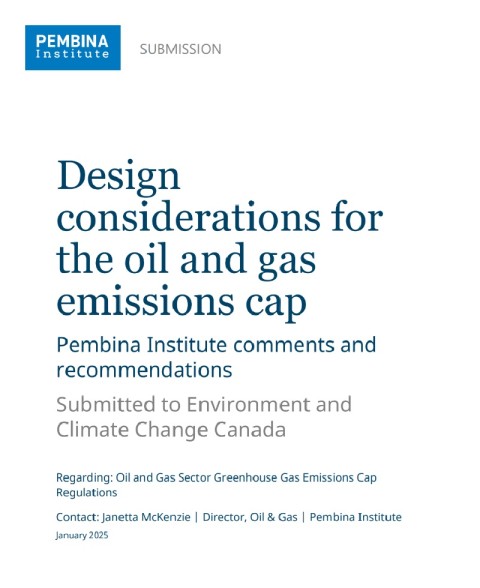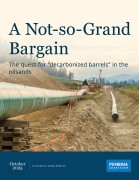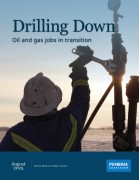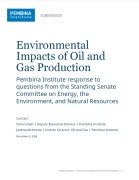In November 2024, the Government of Canada released Canada Gazette 1 of the proposed federal Oil and Gas Emissions Cap. The Pembina Institute welcomes the opportunity to provide input on the development of this regulation.
Canada’s oil and gas industry, which includes both conventional and oilsands production, is the country’s highest-emitting sector, responsible for almost one-third of Canadian emissions annually.
Although existing policies, such as industrial pricing systems and decarbonization funding supports (e.g., the federal Carbon Capture, Utilization and Storage [CCUS] Investment Tax Credit and the Alberta Carbon Capture Incentive Program) are intended to address this issue, the sector’s emissions are not yet declining. Since 2005, oil and gas emissions have increased by 11% (compared with a fall across the whole of Canada’s emissions of seven per cent during the same period). This rise has been driven by the oilsands subsector, where emissions have risen by 142% since 2005 — coinciding with an increase in oilsands production of about 211%, with only modest progress made on reducing oilsands emissions per barrel (known as emissions intensity).
All other oil and gas subsectors (conventional oil, downstream oil and gas, and natural gas production and processing) have begun to achieve reductions in their emissions since 2005. This is likely in large part due to the introduction of federal and provincial methane regulations over the last several years, which have a greater impact on emissions from the conventional sector due to the way methane is associated with conventional methods of oil and gas production. Methane regulations clearly demonstrate how policies can be developed and implemented to achieve real emissions reductions from this complex, high-emitting sector. Also of note is that as conventional producers continue to adhere to methane regulations, any emissions reductions they achieve will count towards meeting the proposed emissions cap.
It is also clear, then, that additional regulation is needed to ensure that the whole oil and gas sector, including the oilsands, begins to meaningfully decarbonize. If it fails to do so, other sectors in the economy will be under greater pressure to reduce emissions faster and further. Investing in decarbonization will also futureproof the sector’s operations so that it can continue to make an important contribution to Canada’s future economy, including in the production of lower-carbon fuels and lower-carbon feedstocks for petrochemicals and other manufacturing.
The proposed level of the cap is not prohibitive
Canada has committed to reducing national emissions by 40–45% below 2005 levels by 2030 and to net-zero by 2050, through the Canada Net-Zero Accountability Act. The objective of this emissions cap regulation is to begin to align the oil and gas industry with that commitment.
We calculated that, based on forecasted emissions to 2026, the proposed regulation is likely to impose an emissions cap that would result in an estimated 22% reduction in emissions from 2005 levels. However, the inclusion of compliance flexibility mechanisms (including the decarbonization fund, which companies can pay into in lieu of reducing actual emissions, and offset credits, which companies can purchase) creates an effective legal upper bound that would represent a minimum actual emissions reduction of 5% below 2005 levels.
Compared with Canada’s economy-wide target, this effective legal upper bound would represent a low contribution from the oil and gas sector. Nevertheless, the creation of this regulation — with the potential to increase stringency over time — is an important step to fully regulate oil and gas emissions and alter their trajectory in a way that can be both meaningful to Canadians and feasible for the industry.








